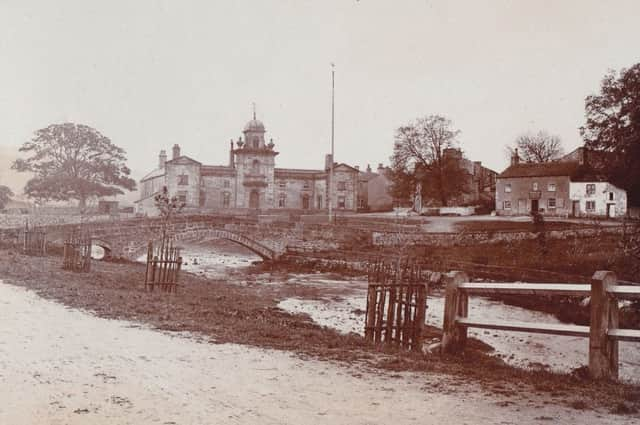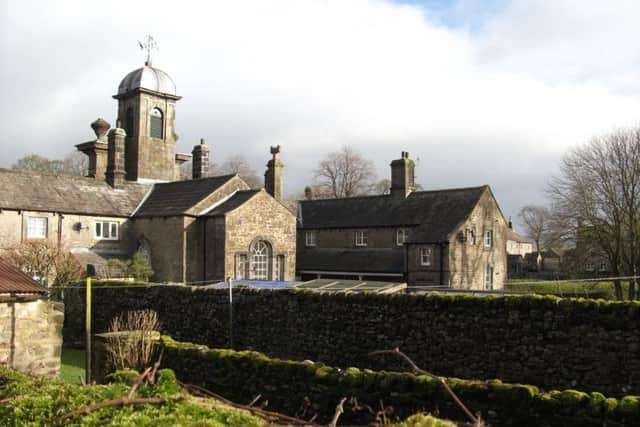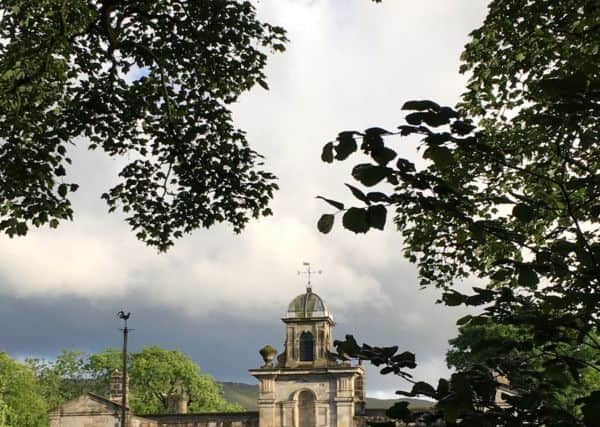The beautiful building that sparked a true Yorkshire Dales mystery


For Jane Houlton and her late husband, architect Michael Devenish, the mystery came in the form of a building. Travelling on a rural bus through the Yorkshire Dales they were suddenly spellbound by the most amazing sight. There on the village green at the chocolate box settlement of Linton-in-Craven was a Baroque masterpiece, a massive yet ornate structure with a towering cupola flanked by urns and supported by giant pilasters. The sort of thing you don’t normally see outside major historic cities, or maybe in the grounds of the most opulent stately homes.
When you have a background in architectural history, no force on earth could have kept you on that bus. Investigating further, they discovered that the building is a functioning almshouse, the Fountaine Hospital Almshouse to give it its full title, still full of residents and still following the model set out by a seventeenth century benefactor. But, beyond that, all was mystery.
Advertisement
Hide AdAdvertisement
Hide AdWhy had Richard Fountaine, born in Linton in 1639 and massively successful in London during the heady times of the Stuarts, have commissioned, of all things, a Baroque almshouse for the poor of his home village? Wasn’t the Baroque – that fashionable, not to say provocatively overblown style, in vogue among the architectural aficionados of the age – rather out of place, to say the very least, among the cottages and farm buildings of a rural hamlet perched among the verdant pastures of remote Wharfedale? And, more than that, who had the mysterious Richard Fountaine got to design it? Because, make no mistake, this is no ordinary building. Hawksmoor, Wren or Vanbrugh could be in the running.


The solving of the mystery entailed many years’ dedicated hard work, delving into archives of the Fountaine family and examining the building itself for clues to its origins. It was a journey that took them right back to the quarry on Thorpe Fell, now deserted and abandoned, which provided the distinctive Yorkshire stone from which the almshouse was built. It took them to the College of Heralds, where a hullabaloo had erupted over Richard Fountaine’s use of his distinctive elephants heads coat of arms, and it took them to the Court of Chancery, where litigation had flown around when it transpired a lavish almshouse was included in Richard Fountaine’s will. This was a mystery, but with an added dash of particularly piquant controversy. Jane Houlton has now written the whole story into a highly engaging volume, An Almshouse for Linton, which has been published by the Devenish Press.
Richard Fountaine himself has long proved to be something of an enigma. Perhaps it’s because that well-known historian Halliwell Sutcliffe, in his famous The Striding Dales (1929), had thrown everyone off Fountaine’s scent with a series of errors, exaggerations and sheer invention. But a truer picture eventually emerged, of a son of Linton who left to become a wealthy haberdasher in the City of London, widely respected among the capital’s fashionable merchant set. He married and seemed likely never to have much to do with his Yorkshire roots again. After all, he was cutting a successful figure in the greatest metropolis of the western world, when commerce, scientific advance, exploration and empire-building were getting into full swing. The folks back in Linton probably thought that was the last they’d ever hear of Richard Fountaine.
His will, however, set the cat among the pigeons. While Linton cousins were pleased to be included, they soon found cause to complain. Why was the unrelated Christian Fountaine included? Family members took umbrage at her clandestine marriage to one Benjamin Stephens, an apothecary, against the conditions of the will.
Advertisement
Hide AdAdvertisement
Hide AdIt took a ruling from the Court of Chancery to establish that Christian had been carer to Richard Fountaine in his later years, and to clear up her status as a legatee. And why of all things, was a new almshouse for Linton stipulated? Surely it would have been better to have divided the loot among all the family members and have done with it? An almshouse means an architect, trustees, costs, residents in perpetuity and endless trouble. The outrage was very real – and that, no doubt, lies behind the mystery. Because most of the documents relating the the almshouse’s design and construction are unaccountably missing.


We do know that the chief executor of Fountaine’s will, John Colton, who had got cracking organising the design of Linton’s almshouse, died in 1724. Everything was disrupted by this, and a shroud seems to descend over the story. But Jane Houlton makes a remarkable discovery. The very building bears a record of this disruption, like an old tree still scarred by a long ago injury.
Surprisingly, the Baroque splendour of the facade of the almshouse gives way to a strangely rustic rear. It’s almost as if one architect has been laid off, and another, with much reduced funding, hired for the rest of the job. The machinations of the family were surely at work here, disrupting a project which – they thought – was eating up their money!
Houlton’s detective work finally comes to a conclusion about who designed the noble frontage of the almshouse. For now the figure of Richard Fountaine has been brought out of the shadows, and the likely architect who carried out his last wishes revealed. Beyond reasonable doubt, the architect was William Etty of York, who was known to have worked with and been influenced by both Vanbrugh and Hawksmoor. For this insight we must be thankful for Jane Houlton’s forensic analysis.
Advertisement
Hide AdAdvertisement
Hide AdAn Almshouse for Linton by Jane Houlton (Devenish Press 2018) is available from Skipton Tourist Information Centre, Yorkshire Dales National Park Centres, Grassington bookshops, or online from: bit./lyRichardFountaine